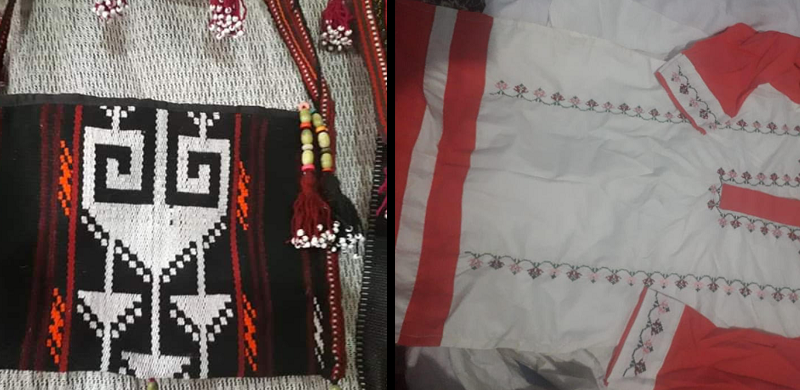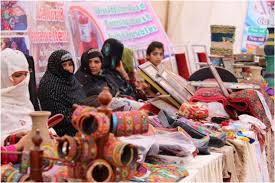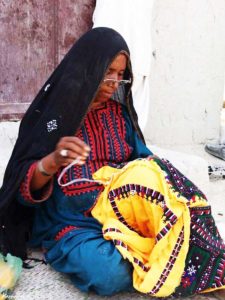
As usual, she keeps coloured pieces of cloth in her lap, tries to focus her gaze while sitting in the corner of a semi-lit room and fits coloured threads in her needle to sew art pieces. Her embroidery are more than just cultural history and tradition for her. These pieces of art are her bread and butter. She struggles to make a living, but is no less than a world-class artist from anywhere in the world.
Zarina Baloch lives in the outskirts of Saryab Road Quetta and she has been an embroidery worker for the last five years.
She smiles but is clearly exhausted. “The embroidery work is hard. It is affecting my vision. To produce enough pieces that they can be put in different exhibitions on different stalls all over the country for sale is not easy”, says Zarina.
The pieces of Balochi embroidery that she produces sell for anywhere from 5,000 PKR to 25,000 PKR. The more time she spends on it, the more is the value of the suit. The simplest embroidery piece takes three to six months. The more complex art work on these suits takes more time.
“If I take direct orders from the people, then they will pay me the exact price. But if we take our pieces to the middle men and merchants in the bazaars, they cash in on lower prices. The middle man has the power to purchase it and sell at higher prices”, says Zarina.
An expert of embroidery, who is an elderly woman and could not mention her name because of the patriarchal and tribal structure of her community, says, “Five-seasonal bird (mosam murgh pach) is a kind of Balochi embroidery that is prepared and sold for around 15,000 PKR apiece. And the seasonal Gul Ghan Gul is another piece sold for around 35,000 PKR. The seven-color Korho goes for 20,000 PKR and the lily season is valued at 50,000 PKR.”
These may seem to be lucrative prices. But she says that a suit can take up to one year to produce. “If the same suit costs you 50,000 PKR, it is still a lesser price in comparison to the hard work that the women do. The middle men, the merchants and stall owners get enough money from these art pieces on suits. But most of the women who produce them are from the rural areas, and they have no direct contact with the market.”

A simple online search shows that the shops sell the same pieces with an extra 20 to 30 percent price on each work prepared by these women. It is hard to generalize too much about prices: the women are, after all, home-based workers. Their business is not registered, and so different shops and stalls have different prices.
۔
Balochistan is a very diverse region indeed. The Pashtuns, the Baloch, the Brahvis, the Sindhis, the people of the Makran coast, the Hazaras, the Punjabis and the Urdu-speaking people live in this province. Each population brings different embroideries. And it is not just embroidery where women take a leading role in production. Much the same role is played by women in industries that manufacture carpets, ceramics, pottery and dried fruit. Even in the scattered agriculture and livestock raising, women take up much of the work.
According to the 2017 census of Pakistan, 12.4 million people live in this region. Women are 5.8 million of that population: making them 47.47 percent of the population in mostly patriarchal and cultural societies of various linguistic and ethnic groups that inhabit Balochistan.
Saima Javed is a rights activist for domestic workers. She defines the sector as follows: “Domestic work is where someone has the liberty to sit anywhere and create her/his pieces at home and sell them in the market.” She is of the view that the domestic workers' economy is yet to be covered through a formal policy. This results in the exploitation of the women who are the direct producers. “The middle men get the surplus value created by the home-based workers”, she says.
“The money they make is not enough to live on. Most of these women are the bread earners of their vast families. These women don’t understand how to connect to the market because of a lack of state policy and government support. If it were not for such limitations, we have the potential to distribute these products in national and international markets for much better prices,” says Saima Javed.
Talhat Jehan runs a center named “Scouts Skills: Learning and Developing” since 2015. She teaches young people the skills as embroiderers, tailors, beauticians and designers. The center is administered by the Trade Testing Board of Pakistan and those who pass through the course are given opportunities for internships. The more brilliant learners become instructors in the same center.
Through the help of UNICEF, the center has trained 1,400 skilled persons so far. Most of the trainers have been home-based workers themselves.
“Embroidery and home-based work is empowering women not just in Pakistan - it is a global trend” says Zolekha Khan Mandokhail, an official of the Chamber of Commerce. “These women are not aware of the market value of their products, because of low literacy and the lack of government resources to polish them and connect them to the open market.”

“There is a dire need for a home-based workers policy from the government and the creation of different vocational institutions. This would surely change our young lot into a productive one and contribute to the economy of the province and the country alike,” says Zolekha Khan.
Article 18 of the 1973 constitution secures everyone's right to their livelihood. The minimum wage for a worker is 17,500 PKR per month. "These home-based workers should have the privileges and safety of their rights under the United Nations International Labor Organization’s 117 C convention,” says lawyer Sabir Qamar.
The Balochistan National Party’s central official Ghulam Nabi Marri is of the view that owing to the low – or in some areas zero – literacy rate, there is a lack of industries and factories. This is causing the unemployment graph to touch the sky.
“On one hand we do not have industries. On the other hand, the government is yet to recognize the home-based workers as labour to be regulated and protected”, says Pir Muhammad Kakar, the general secretary of Pakistan Workers Federation in Quetta. “Old Age Benefits (OBI) would be available for these hard workers if they get recognition through a proper policy by the government of Balochistan.”
“There has been work on the policy through a task force appointed by the government of Balochistan – led by the secretary of the labour department. The task force has members of the Assembly, labour department, various labour organizations, civil society, experts and different INGOs and NGOs. Now the draft is ready,” says Director General Labour and Manpower Saeed Ahmed Sarparah.“So the policy is ready. We are processing it for the legal department. After that, the cabinet and the provincial assembly would approve it.”
Sarparah explains the road ahead after the policy is passed:
“A survey named Rapid Assessment is conducted through the Labour Department of Balochistan, the International Labor Organization and other agencies of the UN. This would collect the data of the people, mostly women who are part of the domestic workforce. Then these workers would be given social security services through registration and a way would be paved for their direct contacts with the market – without the involvement of middle men and exploitation.”
Zarina Baloch lives in the outskirts of Saryab Road Quetta and she has been an embroidery worker for the last five years.
She smiles but is clearly exhausted. “The embroidery work is hard. It is affecting my vision. To produce enough pieces that they can be put in different exhibitions on different stalls all over the country for sale is not easy”, says Zarina.
The pieces of Balochi embroidery that she produces sell for anywhere from 5,000 PKR to 25,000 PKR. The more time she spends on it, the more is the value of the suit. The simplest embroidery piece takes three to six months. The more complex art work on these suits takes more time.
“If I take direct orders from the people, then they will pay me the exact price. But if we take our pieces to the middle men and merchants in the bazaars, they cash in on lower prices. The middle man has the power to purchase it and sell at higher prices”, says Zarina.
An expert of embroidery, who is an elderly woman and could not mention her name because of the patriarchal and tribal structure of her community, says, “Five-seasonal bird (mosam murgh pach) is a kind of Balochi embroidery that is prepared and sold for around 15,000 PKR apiece. And the seasonal Gul Ghan Gul is another piece sold for around 35,000 PKR. The seven-color Korho goes for 20,000 PKR and the lily season is valued at 50,000 PKR.”
These may seem to be lucrative prices. But she says that a suit can take up to one year to produce. “If the same suit costs you 50,000 PKR, it is still a lesser price in comparison to the hard work that the women do. The middle men, the merchants and stall owners get enough money from these art pieces on suits. But most of the women who produce them are from the rural areas, and they have no direct contact with the market.”

A simple online search shows that the shops sell the same pieces with an extra 20 to 30 percent price on each work prepared by these women. It is hard to generalize too much about prices: the women are, after all, home-based workers. Their business is not registered, and so different shops and stalls have different prices.
۔
Balochistan is a very diverse region indeed. The Pashtuns, the Baloch, the Brahvis, the Sindhis, the people of the Makran coast, the Hazaras, the Punjabis and the Urdu-speaking people live in this province. Each population brings different embroideries. And it is not just embroidery where women take a leading role in production. Much the same role is played by women in industries that manufacture carpets, ceramics, pottery and dried fruit. Even in the scattered agriculture and livestock raising, women take up much of the work.
According to the 2017 census of Pakistan, 12.4 million people live in this region. Women are 5.8 million of that population: making them 47.47 percent of the population in mostly patriarchal and cultural societies of various linguistic and ethnic groups that inhabit Balochistan.
Saima Javed is a rights activist for domestic workers. She defines the sector as follows: “Domestic work is where someone has the liberty to sit anywhere and create her/his pieces at home and sell them in the market.” She is of the view that the domestic workers' economy is yet to be covered through a formal policy. This results in the exploitation of the women who are the direct producers. “The middle men get the surplus value created by the home-based workers”, she says.
“The money they make is not enough to live on. Most of these women are the bread earners of their vast families. These women don’t understand how to connect to the market because of a lack of state policy and government support. If it were not for such limitations, we have the potential to distribute these products in national and international markets for much better prices,” says Saima Javed.
Talhat Jehan runs a center named “Scouts Skills: Learning and Developing” since 2015. She teaches young people the skills as embroiderers, tailors, beauticians and designers. The center is administered by the Trade Testing Board of Pakistan and those who pass through the course are given opportunities for internships. The more brilliant learners become instructors in the same center.
Through the help of UNICEF, the center has trained 1,400 skilled persons so far. Most of the trainers have been home-based workers themselves.
“Embroidery and home-based work is empowering women not just in Pakistan - it is a global trend” says Zolekha Khan Mandokhail, an official of the Chamber of Commerce. “These women are not aware of the market value of their products, because of low literacy and the lack of government resources to polish them and connect them to the open market.”

“There is a dire need for a home-based workers policy from the government and the creation of different vocational institutions. This would surely change our young lot into a productive one and contribute to the economy of the province and the country alike,” says Zolekha Khan.
Article 18 of the 1973 constitution secures everyone's right to their livelihood. The minimum wage for a worker is 17,500 PKR per month. "These home-based workers should have the privileges and safety of their rights under the United Nations International Labor Organization’s 117 C convention,” says lawyer Sabir Qamar.
The Balochistan National Party’s central official Ghulam Nabi Marri is of the view that owing to the low – or in some areas zero – literacy rate, there is a lack of industries and factories. This is causing the unemployment graph to touch the sky.
“On one hand we do not have industries. On the other hand, the government is yet to recognize the home-based workers as labour to be regulated and protected”, says Pir Muhammad Kakar, the general secretary of Pakistan Workers Federation in Quetta. “Old Age Benefits (OBI) would be available for these hard workers if they get recognition through a proper policy by the government of Balochistan.”
“There has been work on the policy through a task force appointed by the government of Balochistan – led by the secretary of the labour department. The task force has members of the Assembly, labour department, various labour organizations, civil society, experts and different INGOs and NGOs. Now the draft is ready,” says Director General Labour and Manpower Saeed Ahmed Sarparah.“So the policy is ready. We are processing it for the legal department. After that, the cabinet and the provincial assembly would approve it.”
Sarparah explains the road ahead after the policy is passed:
“A survey named Rapid Assessment is conducted through the Labour Department of Balochistan, the International Labor Organization and other agencies of the UN. This would collect the data of the people, mostly women who are part of the domestic workforce. Then these workers would be given social security services through registration and a way would be paved for their direct contacts with the market – without the involvement of middle men and exploitation.”
